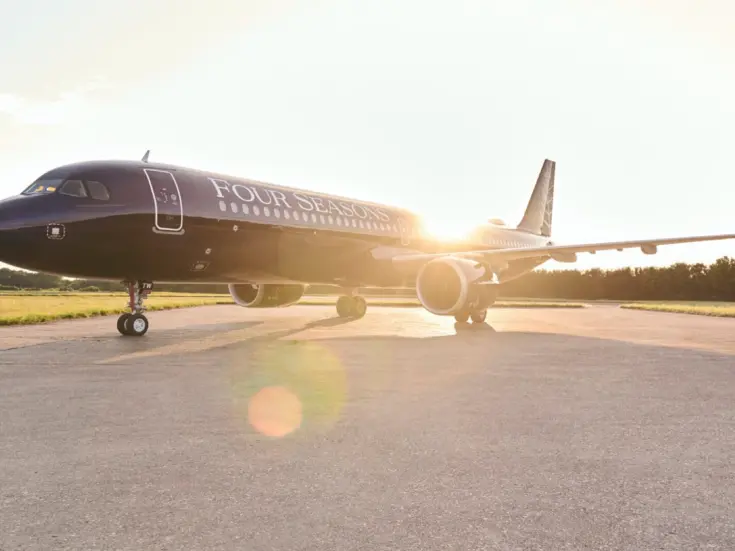
Piste is East
Think Courchevel without the queues, Aspen without the attitude — and more powder than a Johnson & Johnson factory. Rory Ross on why serious skiers will soon be schussing their way to Japan
EUROPE’S CROWDED AND globally warmed ski slopes can make winter holidays in the Alps a costly and frustrating gamble on the weather — and that’s before you factor in the soaring Swiss franc, which this season will cause knock-on congestion in euro-denominated resorts. However, an alternative skiing opportunity beckons: Japan.
The ski slopes near Sapporo on Hokkaido island represent Japan’s premier powder playground, home to some of the lightest, finest, fluffiest and most abundant snow on the planet. As yet, relatively few people, not least the Japanese themselves, have caught on.
Powder seekers should head to Niseko village, Japan’s top resort located 80 miles west of Sapporo, set against the soaring backdrop of Mount Yotei (1,893 metres), a Fuji-like volcano and Niseko’s icon. Opened in 1982, Niseko village edges Europe and the States in several respects: no crowds, orderly queues, polite service, 40 days of powder per season dumped fresh from Siberia (in Europe, you’re lucky to get more than six), superb off-piste skiing slaloming through silver birch forests, and excellent Japanese food. Japan is crying out for tourism post-tsunami, so visitors can expect a warm welcome.
There are two hotels in Niseko: the Hilton and the smaller Green Leaf. Both belong to YTL Hotels of Malaysia, whichowns the entire resort. The Green Leaf is narrowing the hospitality gap with the world’s other top resorts. With an interior bathed in the healthy glow of natural materials, it offers a pared-back ‘contemporary ski lodge experience’ and wraps a spa, onsen (communal bath), restaurant and lounge bar with a convenient ski-in, ski-out location at the foot of Mount Niseko-Annupuri, Mount Yotei’s smaller neighbour. Were someone to open your bedroom window, a well-aimed jump would have you skiing into bed.
Hokkaido is Japan’s northernmost island. In winter, freezing Siberian winds draw moisture from the Sea of Japan and dump it on the first large obstacle they hit, Mount Niseko-Annupuri, which peaks at 1,308m — low-altitude by the standards of European ski resorts. But the snow! From January, the Siberian Express delivers a six-week nonstop service amounting to Snowmageddon. January 2011 was the snowiest since 2005: accumulated snowfalls measured more than four metres. Only Mount Baker in the USA is snowier.
We’re talking quantity and quality. Light and dry thanks to low temperatures and low humidity, the snow offers minimal resistance and gives ‘a feeling of controlled falling which some people find addictive’, says Pam Challoner from Canada, head of marketing and communications at the Green Leaf. ‘Air in the snow makes the snow feels like it has no density.’ The snow also makes superb ammunition for snowball fights.

The Austrians introduced skiing to Japan 80 years ago. The sport leapt during the Eighties, when tax incentives saw the number of ski resorts rise to nearly 800. However, the Japanese themselves were only ever pretending; they never really ‘got’ skiing. By the late Nineties, despite the Winter Olympics in Nagano in 1998, the sport was going downhill fast. Lift systems deteriorated; resorts were abandoned.
Now, skiing is back. Thanks to demand from expatriate Europeans based in Asia who are discovering Niseko’s unique charms, the Bamboo Network of China, Malaysia and Singapore is beginning to invest. ‘Niseko is becoming the Bali of winter sports,’ says Panch Ratnavale, resort director at the Green Leaf, a reference to Niseko’s popularity among Australians.
Prices of lodges and apartments with views of Mount Yotei are beginning to pop, thanks to Niseko’s year-round credentials (the village is surrounded by six national parks, golf courses, etc). In 2013, Christina Ong will open a Como hotel in Niseko, a huge vote of confidence in the area that should underpin prices while also starting an avalanche of other resort hotels. I predict that Niseko will soon schuss past Aspen as the most desirable non-European powder fix.
Olivia Harper, the American wife of a Hong Kong-based banker, typifies the Niseko newcomer. ‘My family always stays in Hirafu village [neighbour of Niseko], where most of the interesting small bars and restaurants are located. The food is delicious and the Japanese are ultra-polite. Even on a busy day, the lift queues are tame compared to crowds elsewhere.’
The silver birches that bristle the mountainsides and fringe the ski runs add a characteristic scenic element. Unlike the pines and firs of Europe, birches are deciduous. Close up, the tangle of stark silver branches mantled in thick snow lend the mountainside an eerie appearance like the aftermath of some cataclysm or a contemporary art installation. They also make off-piste skiing easier.

Stopping off at an on-hill log cabin for ramen noodles and katsu curry (curry rice served with breaded pork cutlet) washed down with sake and Sapporo beer, I meet Duncan Worrell, founder of snowboardclub.co.uk. ‘Birches admit more light and snow than evergreens, which makes off-piste more fun,’ he says. ‘Speaking as a snowboarder, I’d happily sleep in a broom cupboard for snow this good — even when the snow is chopped up, you breeze through it. The only snag is that as the tree-trunks are silver, a white-out could be a problem.’
THE NISEKO SEASON unfolds from 1 December to late April. ‘It ends when the golf season tees off,’ says Pam Challoner. January is the quietest month, while in March the lengthening afternoons ease the tempo a notch or two. Most days are powder days, and I don’t mean overnight forensic dustings, but waist-deep dumpings. ‘Two weeks ago, two metres fell in three days,’ says Challoner. ‘The quality is so good that you don’t mind doing the same run several times.’ Avalanches are a perennial threat, so going deeply off-piste is generally discouraged, but then why would you when there’s hardly anyone around?
It isn’t just about the powder. Niseko offers something you rarely find in Europe: the unmistakeable Japanese touch rendered in orderly queues (you don’t get the elbow in the eye in the lift queues that you get in Europe), unfailing politeness, smiles and an all-round emphasis on extreme functionality. An Englishman will never feel more foreign than in provincial Japan, but the locals are extremely welcoming and pride themselves on not inconveniencing guests.
Then there’s the après-ski. The Green Leaf has its own onsen, indoor and outdoor pools fed by mineral-rich volcanically heated spring waters that gush at 53.2°C. Cooled to just over 40°, the waters are fed into natural pools set in a sunken Zen rock garden. To marinate chin-deep in a steaming outdoor rockpool while the Siberian Express makes its daily delivery is an unmissable stress-reliever. After a bamboo massage in the spa, I was ready for dinner.
Niseko defies my rule of thumb that the quality of catering of any resort is in inverse proportion to its altitude and the views. The food is world-class. Hot summer sun combines with clean air, mineral-rich, unpolluted waters and volcanic soil to make Niseko the breadbasket of Japan. One of the best gastro-opportunities is the Hilton, where ex-heavy metal drummer and karaoke-lover Rob Shipman, formerly of the Hempel Hotel and Nobu, is the head chef.
Japan guarantees the best powder in one of the most beautiful places. But how to justify the long haul from Europe? Easy. It’s barely any further than Colorado or Whistler. Furthermore, you get a cognitive bias thrown in for free, according to Pam Challoner: ‘I find that the more resources visitors throw at their skiing holiday, the more they become invested in enjoying it.’
British Airways (ba.com) flies daily to and from Tokyo Haneda using the Boeing 777 in a three-class configuration, Club World, World Traveller Plus and World Traveller. Rory travelled as a guest of the Roving Ambassador, based in Cape Town, New York and London (www.tourismcorp.co.za)
Rory Ross is a freelance journalist who knows everything about going downhill fast








